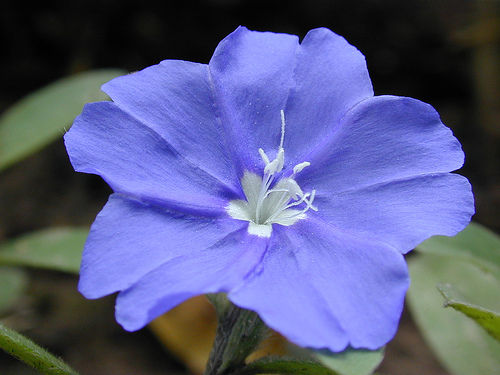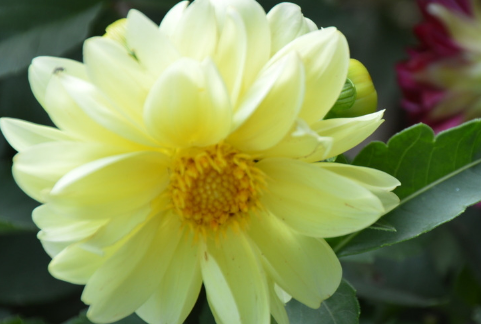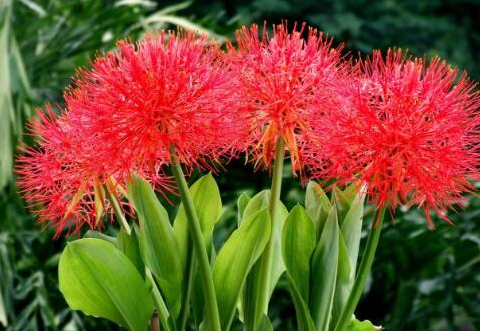Matters needing attention in the Culture of Blue Star Flower
1. Pruning
Blue star flowers in winter will enter dormancy or semi-dormancy period, to cut off weak branches, diseased branches, withered branches, dense branches and other branches. The branches can also be arranged in combination with cuttings.
two。 Reproduction method
The propagation mode of blue star flower is mainly sowing propagation and cutting propagation.
3. Change the basin
The blue star flower grows very fast, when the plant grows up, we should consider changing it to a larger pot, usually we choose to change the pot in spring.

At this point, the introduction of blue star flower culture methods has come to an end. After reading the introduction, do you think it is very simple? Are you planting blue star flowers in the right way? Blue star flowers are flowering all the year round, and convenient breeding is very popular!
How to raise blue star flowers? Culture methods and matters needing attention of Blue Star Flower
Blue star flower is a perennial plant of the genus Cyanthus of Convolvulaceae, which is a common potted ornamental flower indoors. Blue Star Flower has blue flowers, fresh and beautiful, with high ornamental value. So, how to raise blue star flowers? The breeding methods and matters needing attention of Blue Star Flower are introduced as follows.
Picture: blue Star Flower
I. Culture methods of Blue Star Flowers
1. Light and temperature: blue star flowers like the sun, strong adaptability to light, can be full-day or half-day sunshine. Put in indoor maintenance, to make it exposed to sunlight, get sufficient light, lack of light, plant overgrowth, but also affect flowering. The blue star flower is native to the subtropics, and its suitable growth temperature is 20-30 degrees. In winter, the overwintering temperature will be relatively high. When the temperature is below 8 ℃, it will stop growing and enter dormancy.
two。 Humidity requirements: blue star flowers prefer a wetter environment, requiring an air temperature of between 50 and 70%. The air humidity should not be too low, otherwise there will be yellowing and shedding of the lower leaves and no luster of the upper leaves.
3. Water and fertilizer management: water is very important for blue star flowers. Spring, summer and autumn are the growing seasons of blue star flowers. Sufficient water should be given, especially in summer, plants can not be short of water, and watering can be increased when the temperature is high. Blue star flowers will go dormant in winter, which can reduce the number of watering times. As the flowering period of Blue Star flower can be said to be all year round, it blossoms almost all the year round, so it needs to be supplemented with fertilizer frequently. More fertilizer can be added during the growing season. Should pay attention to add some organic fertilizer on the basin, and apply the quick-acting fertilizer regularly every month.
Picture: blue Star Flower
II. Matters needing attention in Blue Star Flower Culture
1. Pruning: blue star flowers will enter dormancy or semi-dormancy period in winter, and cut off weak branches, diseased branches, withered branches, dense branches and other branches. The branches can also be arranged in combination with cuttings.
two。 Propagation method: the propagation mode of blue star flower is mainly sowing reproduction and cutting propagation.
3. Change pot: the growth rate of blue star flower is very fast, when the plant grows up, it should be considered to change a larger basin, the change time can be spring.
[editor's conclusion] Blue Star flowers like wet or semi-dry environment, and the required growth environment humidity is 50%, 70%, which requires special attention in the maintenance process. Above for you to introduce the blue star flower culture methods and matters needing attention, I hope to be able to help you!
Culture methods and matters needing attention of Blue Star Flower
Latin name blue daze
Don't call it star flower or umbrella flower.
The plant kingdom.
Phylum angiosperm
Dicotyledonous class
Subclass chrysanthemum
Solaniformes
Family Convolvulaceae
Belonging to the genus Cyanthus
Distribution area America
Blue star flower is a perennial semi-trailing evergreen shrub. Flowering throughout the year, suitable for courtyard beautification, flower beds, potted plants or ground covers. It is native to America. Like sunlight and fertile sandy soil, if the light is not enough, the branches are easy to grow, the flowering situation is not good, for water supply is also very important, if the lack of water for a long time, it is not easy to restore plants. The blue star flowers only bloom in the morning and all in the afternoon, and there is no one left.
1. Morphological characteristics.
Leaves: leaves alternate, long oval, entire, dorsally densely covered with white hairs.
Stem: plant height 30cm to 60cm. Stem semi-trailing, densely covered with white hairs.
Flowers: flowers are axillary, synpetalous, Corolla 5-lobed blue, central white star. It can blossom all year round.
Semi-trailing evergreen shrubs. The sex likes the high temperature, the sunshine needs good. The plant is 30-60 cm tall, and the stems and leaves are densely covered with white hairs. Leaves alternate, long oval, entire. Flowers axillary, synpetalous, Corolla blue, central white star. It can blossom all year round.
2. Growth environment
Like the humid or semi-dry climate environment, the relative temperature of the air in the growing environment is required to be 50-70%. When the air relative humidity is too low, the lower leaves yellowing and falling off, and the upper leaves are not glossy. The temperature in winter is very strict, and the growth stops when the ambient temperature is below 8 ℃.
3. Distribution
It is native to America.
4. Cultivation techniques
Sowing and propagation I. seed selection
Before sowing, we should first select the seeds. Whether the seeds are good or not is directly related to the success of sowing.
1. It is best to choose the seeds harvested in the same year. The longer the seed is preserved, the lower the germination rate is.
2. Choose full seeds without defective or deformed seeds.
3. Select the seeds free from diseases and insect pests. Disinfection: disinfection includes two concepts, one refers to the disinfection of seeds, and the other refers to the disinfection of sowing substrates. Families usually soak the seeds in hot water for about 60 ℃ for a quarter of an hour, and then use warm hot water to accelerate germination for 12 to 24 hours. The best way to disinfect the substrate used for sowing is to stir-fry it in a pan so that any diseases and insects can be scalded to death.
Second, accelerating budding
Soak the seeds in warm hot water (the temperature is about the same as facial wash) for 12 to 24 hours until the seeds absorb water and expand. For common seeds that germinate easily, this work does not have to be done.
Third, sowing seeds
For small seeds that are difficult to pick up with hands or other tools, wet one end of the toothpick with water, stick the seeds one by one on the surface of the matrix, cover the substrate 1 cm thick, and then put the seeding flowerpot into the water. the depth of the water is 1 foot 2 feet 2 tap 3 of the height of the flowerpot, allowing the water to soak up slowly (this method is called "pot immersion"). For larger seeds that can be picked up by hand or other tools, put the seeds directly into the substrate and order them at a distance of 3 × 5 cm. After sowing, the substrate was covered, and the thickness of the cover was 2-3 times that of the seed. After sowing, you can wet the sowing matrix with sprayers and fine-hole showers. Later, when the basin soil is slightly dry, you should still pay attention to the watering strength so as not to wash the seeds up.
IV. Management after sowing
After sowing in late autumn, early spring or winter, when you encounter a cold wave and low temperature, you can wrap the flowerpot with plastic film to keep warm and moisture. after the seedlings are unearthed, the film should be opened in time and before 9:30 every morning. or let the seedlings receive the sun after 3:30 in the afternoon, otherwise the seedlings will grow very weak. After most of the seeds come out, they need to plant seedlings properly: pull out the diseased and unhealthy seedlings, so that the seedlings left behind have a certain space between each other; when most of the seedlings have three or more leaves, they can be transplanted.
- Prev

Matters needing attention in sowing Xiaoli
1. Soil Xiaoli flower pot planting chooses loose, fertile, good drainage sandy soil, should not use clayey soil. two。 Temperature Xiaoli tenacious vitality, summer high temperature can also grow normally, but it is best to keep the temperature at 15-20 ℃, more conducive to seed germination. 3. Watering seeds should be watered in time after sowing
- Next

Propagation method of tennis flower
Ball propagation tennis flowers are generally propagated in spring, take out the plant, shake off the soil, gently break off the new balls around the mother ball, and plant them respectively. Usually tennis flowers need to be propagated once every two or three years, and the bulbs should not be buried too deep, and a small amount of water can be watered after germination.
Related
- Fuxing push coffee new agricultural production and marketing class: lack of small-scale processing plants
- Jujube rice field leisure farm deep ploughing Yilan for five years to create a space for organic food and play
- Nongyu Farm-A trial of organic papaya for brave women with advanced technology
- Four points for attention in the prevention and control of diseases and insect pests of edible fungi
- How to add nutrient solution to Edible Fungi
- Is there any good way to control edible fungus mites?
- Open Inoculation Technology of Edible Fungi
- Is there any clever way to use fertilizer for edible fungus in winter?
- What agents are used to kill the pathogens of edible fungi in the mushroom shed?
- Rapid drying of Edible Fungi

